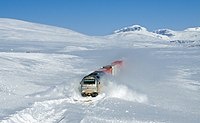
Photo from wikipedia
A high-resolution (4 km) regional climate simulation conducted with the Weather Research and Forecast (WRF) model is used to investigate potential impacts of global warming on skiing conditions in the… Click to show full abstract
A high-resolution (4 km) regional climate simulation conducted with the Weather Research and Forecast (WRF) model is used to investigate potential impacts of global warming on skiing conditions in the interior western United States (IWUS). Recent past and near-future climate conditions are compared. The past climate period is from November 1981 to October 2011. The future climate applies to a 30-year period centered on 2050. A pseudo global warming approach is used, with the driver re-analysis dataset perturbed by the CMIP5 ensemble mean model guidance. Using the 30-year retrospective simulation, a vertical adjustment technique is used to determine meteorological parameters in the complex terrain where ski areas are located. For snow water equivalent (SWE), Snow Telemetry sites close to ski areas are used to validate the technique and apply a correction to SWE in ski areas. The vulnerability to climate change is assessed for 71 ski areas in the IWUS considering SWE, artificially produced snow, temperature, and rain. 20 of the ski areas will tend to have fewer than 100 days per season with sufficient natural and artificial snow for skiing. These ski areas are located at either low elevations or low latitudes making these areas the most vulnerable to climate change. Throughout the snow season, natural SWE decreases significantly at the low elevations and low latitudes. At higher elevations changes in SWE are predicted to not be significant in the mid-season. In mid-February, SWE decreases by 11.8% at the top elevations of ski areas while it decreases by 25.8% at the base elevations.
Journal Title: Journal of Applied Meteorology and Climatology
Year Published: 2021
Link to full text (if available)
Share on Social Media: Sign Up to like & get
recommendations!